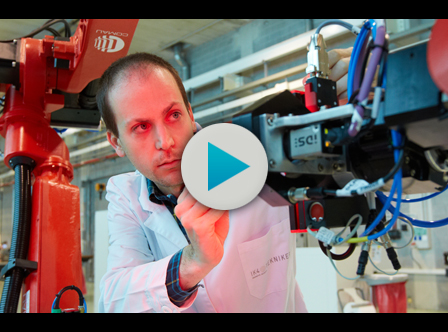PROJECTS
The aim of IK4-TEKNIKER is to incorporate dual manipulator robots into industry by developing technologies like 3D perception, sensor integration (vision and force) or detection of humans.
Industrial robotics has brought reliability, cost cutting and precision to production across a whole range of industries. Yet there are certain types of production that even today need human intervention in some of its phases due to its complexity or the high cost of automation.
Right now, cutting-edge technologies are gradually handling these tasks with increasingly capable robots. Nevertheless, the progressive complexity of production processes is posing a fresh challenge for developers of robots: human-robot interaction.
This is one of the main strengths of the dual manipulator robot that the Basque R&D centre IK4-TEKNIKER will be showcasing at the Machine Tool Biennial, due to be held at the BEC in Barakaldo (Basque Country) from 2 to 7 June.
The robot, equipped with two arms and a torso and which the centre will be presenting at the BIEMH-Machine Tool Biennial, addresses practical production demands and, what is more, provides solutions that allow flexible automation in a range of applications for sectors like aircraft and domestic appliances. At the trade fair the robot will be demonstrating the assembly and disassembly of a unit incorporated into a Redox battery.
The audience will be able to see how the robot is capable of collaborating with the operative, made possible by applications like the monitoring of its surroundings and capabilities for interacting and coordinating with personnel.
The other great sphere of interaction with humans is the safety issue. Bearing in mind that the robot is designed to work in a collaborative environment in which the technician and the robot will be sharing an open, barrier-free physical space, systems for perceiving the surroundings that will allow safe interaction between humans and robots need to be developed.
These capabilities are the result of technologies applied by the centre's researchers; they include data analysis for detecting and segmenting purposes, particle filters for monitoring, the tracking of multiple targets, and sensors for correcting trajectories (Visual Servoing).
The robot offers high performance in terms of safety. Many of the technologies built into it have been developed for the European FLEXASS and X-ACT projects; these are geared towards developing advanced systems of cooperation within manufacturing and assembly facilities in Europe.
IK4-TEKNIKER's participation in the two projects addresses the aim of incorporating dual manipulator robots into industry by developing technologies like 3D perception, sensor integration (vision and force) or detection of humans.
IK4-TEKNIKER's Autonomous & Intelligent Systems Unit has broad experience in developing robotic systems, and is currently working on 5 European projects in the field of robotics. Furthermore, on behalf of the IK4 Alliance, it is a founder member of the Steering Committee of euRobotics aisbl, the body that advises the European Commission on robotics research.





